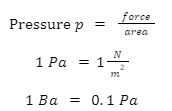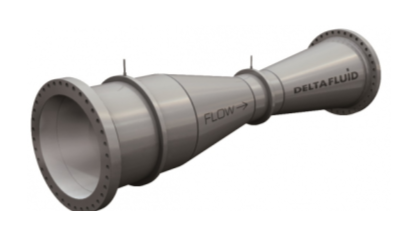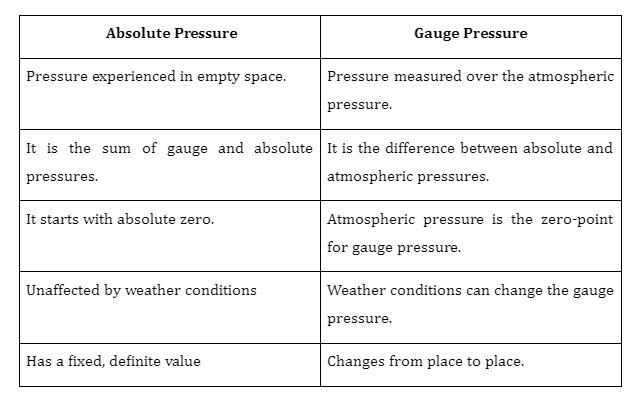Introduction
The concept of pressure plays an integral role in our daily activities. For instance, a knife edge exerts a large amount of pressure on fruits and vegetables. While the science behind it may be new for some people, this occurs because the edge of the knife is very sharp. Surfaces that have small areas exert larger amounts of pressure and it is this property that enables us to cut fruits and vegetables using knives.
It is also pressure that allows various other devices like pumps and vacuum cleaners to function.

What is Pressure?
Pressure is the term used to describe the force applied on an object per unit area of the surface in a perpendicular direction and thus, it can be expressed as the ratio of force to area. Most commonly, we use the symbol ‘p’ to denote pressure and measure in the Sl unit of Pascal (Pa). In CGS systems, its unit is barye (Ba). Note that it is a scalar quantity with only magnitude and no direction.

For liquids, we define a quantity known as thrust. It is the total force acting on the surface of a solid that is touching the liquid. Thus, it has the same units as force and the formula also doesn’t differ:
\[thrust = pressure \times area\]
Hence, for liquids, we can also find pressure as thrust per unit area.

Pascal’s law states that pressure in a liquid is transmitted equally in all directions and thus, pressure at any point is unaffected by the shape of the vessel. The pressure exerted by the liquid at any given point is uniform and the force exerted by a liquid at rest is always normal to the surface in contact with it.
Mathematically, the pressure at any point within the liquid is directly proportional to its density as well as the height of the liquid column above it. Hence, we can relate pressure at any point in a liquid column to these two quantities via the relation
\[{\bf{p}} = {\bf{h}}\rho {\bf{g}}\]
Here, is the density of the liquid, h is the height above it, and g is acceleration due to gravity.
Types of Pressures
1. Absolute Pressure:
Absolute pressure is the measurement of pressure in vacuum or empty space. It is measured from the absolute zero or absence of pressure and may be given as the combination of atmospheric and gauge pressure.
Absolute pressure = Atmospheric pressure + Gauge pressure
As an example, if we have
Gauge pressure = 14 psi
Atmospheric pressure = 30.5 psi
Absolute pressure = 14+ 30.5=44.5 psi
2. Gauge Pressure:
Gauge pressure refers to the pressure that is measured above the atmospheric pressure. When the atmospheric pressure is low, the gauge pressure will have a positive value, and vice versa. We can measure gauge pressure via the use of instruments known as manometres and gauges.
Gauge pressure = Absolute pressure – Atmospheric pressure
3. Differential Pressure:
As implied by the name, differential pressure is a measure of the pressure difference that exists between two points. If \({P_{a}}\) and \({P_{b}}\) are pressures at two points a and b, then the differential pressure is given as

Venturi tube is a device that can best demonstrate the concept of differential pressure. It is used to measure the flow of fluids and can change the pressure in the middle, making it best suited to measure liquid pressure.

4. Sealed Pressure or Vacuum Pressure:
Vacuum is defined as a portion of space wherein there exists no matter and thus, it has zero pressure. Practically, such a condition is hard to achieve but a close enough situation may be arrived at by using sealed containers made of very strong materials.
What is Gauge Pressure?
Pressure measured over the atmospheric pressure is known as gauge pressure and it can be calculated as follows:
Local atmospheric pressure = 14.2psi
Absolute pressure = 28 psi
Gauge pressure = Absolute pressure – Atmospheric pressure
Gauge pressure= 28-14.2=13.8psi
Sometimes, we also refer to it as overpressure. It gives us an idea about the atmospheric weight of a point and is different under different weather conditions and sea level.
Relation Between Atmospheric Pressure and Gauge Pressure:
Pressure exerted by the atmosphere at any point is referred to as atmospheric pressure. The atmosphere is composed of a mixture of various gases and these gases exert a pressure due to the weight of the molecules above it.
We can relate gauge pressure and atmospheric pressure via the absolute pressure
Gauge pressure = Absolute pressure – Atmospheric pressure
Since absolute pressure is fixed, gauge pressure must become negative if the atmospheric pressure exceeds a certain threshold and vice versa.
Difference between Absolute and Gauge Pressure

Summary
Pressure is something fundamental that we experience in our everyday activities but often fail to notice. From cutting fruits with a knife-edge to breaking stones using chisels, our actions involve some level of pressure in one way or another. The amount of pressure required to do some task depends on where and how the force or thrust is applied as well as the area it is applied on. Mathematically, pressure is given as the ratio of force and area and thus, is higher for smaller areas.
Frequently Asked Questions
1. Explain the Bourdon Gauge instrument?
This instrument can directly measure gauge pressure and thus, is utilised extensively in industrial settings to measure both small and large pressures.
2. What are Barometers?
The instruments used to measure atmospheric pressure are known as barometres. The most common and widely used type of barometer is the cistern-type Fortin’s Barometer. Another handy type is the aneroid barometer which does not use any liquid inside it.
3. A bike tire measures a gauge pressure of 35 psi. Find the Absolute Pressure.
Given that,

4. Football shoes have studs on them. Does the concept of pressure play a role here?
Studs have smaller surface areas and thus, exert higher pressure, allowing them to sink into the ground and provide a better grip.
5. What is Atmospheric Pressure?
Ans: Pressure exerted by the atmosphere is known as atmospheric pressure and it is present everywhere on Earth. Its value decreases as we go higher up.
 Mission Statement
Mission Statement
“Empower every student to achieve full potential”
88Guru has been established with the social objective of making quality video-based learning material available to all Indian students. Technology, Connectivity and Social Media are rapidly changing the world of Education and we wish to lead the transformation of the tuition industry in India.
88Guru is the perfect complement to the current tuition model. 88Guru creates a wonderful opportunity for children and parents to bond while engaging in a valuable learning activity. It also provides the complete curriculum at your fingertips for those moments when you need some help at short notice. We believe that this mode of tuition could be transformational, adding hours to a child's day while providing complete control over the learning process.
Every course is taught by the best teachers from India's top schools and conducted in an engaging manner to keep students involved. The e-learning process consists of video-based instructions, computer-graded assignments, and a dashboard which allows the student and parent to track progress.


